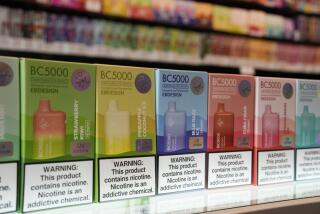Drawing a Line on Kids, Cigarettes : Big tobacco rails, but FDA proposals are welcome
- Share via
In an attempt to bury the issue of tobacco use by minors, major cigarette companies and their allies have submitted an imposing 2,000-page response--plus 40,000 pages in appendices--opposing the U.S. Food and Drug Administration’s proposal to institute limits on the sales and advertising of cigarettes. Despite the blizzard of paperwork and PR, the FDA has kept the nation’s attention focused on the issue at hand: protecting youngsters from a harmful and addictive product that every year hooks 1 million more kids and kills more than 400,000 Americans.
The new FDA rules, designed to ensure the rights of smoking adults but curb unfettered access to children and teens, would ban cigarette sales from vending machines and ban tobacco giveaways. The proposal would also tame aggressive marketing efforts the FDA deems aimed at children by prohibiting billboard tobacco ads within 1,000 feet of a school or playground; requiring cigarette companies, not brands, to be designated as the sponsor for sporting events (i.e., Philip Morris Cos. Inc., not Marlboro), and remove a sense of glamour from cigarette advertising by requiring black-and-white ads in publications read by significant numbers of children.
Ultimately, the public battle of words will be settled in the courts and probably with federal legislation.
Predictably, the tobacco companies have counterattacked with all that their deep pockets can muster. Wherever they can find a sympathetic ear, industry representatives argue that government is exceeding its regulatory authority and violating the Constitution by limiting the First Amendment rights of advertisers.
But that approach may not work. The Supreme Court has ruled that commercial speech does not enjoy the same broad constitutional protections as political or artistic speech. And in the case of cigarette advertising, where the image of hip and cool ignores potential long-term health damage, the worst kind of misleading information is being purveyed.
Behind the gloss of advertising and promotion, the tobacco industry’s own documents held the ultimate dirty little secret: The companies knew that nicotine was addictive, though they argue to this day over the degree of addiction and whether in fact that is the proper term for whatever it is that keeps the customers coming back.
The FDA estimates that its rule changes on selling, promoting and advertising cigarettes and other tobacco products would cost tobacco companies about $230 million annually. But, in the balance, that’s not much when weighed against the potential national savings in health costs of $4.3 billion.
More to Read
Sign up for Essential California
The most important California stories and recommendations in your inbox every morning.
You may occasionally receive promotional content from the Los Angeles Times.













